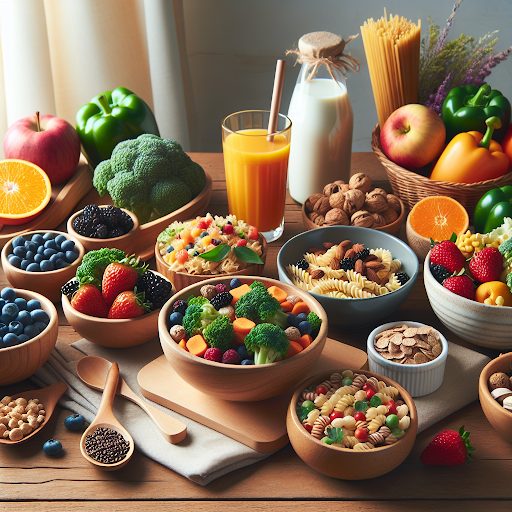Fueling Your Plant-Based Journey: Exploring High Fiber Vegan Foods
Embarking on a vegan lifestyle doesn’t mean compromising on essential nutrients, especially fiber. As a nutritionist with a deep appreciation for high-fiber foods and a particular fondness for bananas, I’m excited to guide you through the world of high-fiber vegan foods. In this comprehensive guide, we’ll explore plant-based options that not only support your fiber intake but also contribute to overall health. Let’s dive into the abundance of fiber-rich, vegan-friendly choices that will energize your plant-based journey.
Understanding the Fiber Advantage in a Vegan Diet:
Why Fiber Matters in a Vegan Lifestyle:
A vegan diet, based on plants, is naturally rich in fiber. Dietary fiber is essential for digestive health, weight management, and overall well-being. Let’s explore the types of fiber and why they are vital for a thriving vegan lifestyle.
Types of Dietary Fiber
| Type of Fiber | Solubility | Sources |
| Soluble Fiber | Dissolves in water | Oats, beans, fruits, vegetables |
| Insoluble Fiber | Does not dissolve | Whole grains, nuts, seeds, vegetables, fruit |
The Fiber-Rich Vegan Pantry:
Now, let’s delve into a detailed exploration of high-fiber vegan foods, showcasing their nutritional profiles and versatility.
Legumes:
Lentils: Packed with protein and fiber, lentils are a vegan staple. One cup of cooked lentils provides around 16 grams of dietary fiber.
Chickpeas: Versatile and delicious, chickpeas offer approximately 12 grams of fiber per cup when cooked.
Whole Grains:
Quinoa: A complete protein, quinoa is also a fiber powerhouse, providing 5 grams per cup when cooked.
Brown Rice: A wholesome choice, one cup of cooked brown rice contains about 4 grams of fiber.
Fruits:
Bananas: With approximately 3 grams of fiber per medium-sized banana, this fruit is not only convenient but also contributes to a balanced pH level in the body, supporting digestive health.
Berries: Blueberries, raspberries, and strawberries are not only rich in antioxidants but also high in fiber, with about 3-4 grams per cup.
| Food | Fiber Content (per 100g or 1 cup) |
| Lentils | 8g |
| Chickpeas | 7.6g |
| Quinoa | 2.8g |
| Brown Rice | 1.8g |
| Banana | 2.6g |
| Blueberries | 3.6g |
| Almonds (nuts) | 12.5g |
Exploring the Fiber Benefits of Bananas:
Now, let’s embark on a detailed exploration of bananas, a beloved fruit that not only adds sweetness to vegan dishes but also contributes significantly to the fiber content of a plant-based diet.
Nutritional Profile of Bananas
| Nutrient | Amount per 100g |
| Calories | 89 |
| Carbohydrates | 23g |
| Dietary Fiber | 2.6g |
| Sugars | 12g |
| Protein | 1.1g |
| Fat | 0.3g |
| Vitamin C | 8.7mg (15% DV) |
| Potassium | 358mg (10% DV) |
Balancing Act: The pH of Bananas
Bananas exhibit a slightly acidic pH level, ranging from 4.5 to 5.2. This inherent acidity serves as a harmonious balance in the body, particularly in the digestive system. Let’s delve into the ways in which bananas contribute to the overall health of those on a vegan journey.
Digestive Harmony:
The soluble and insoluble fiber content in bananas makes them a digestive powerhouse. Soluble fiber aids in slowing down the absorption of sugar, contributing to stabilized blood sugar levels. Additionally, this soluble fiber forms a gel-like substance in the digestive tract, assisting in the gentle removal of waste.
Nutrient Density:
Beyond fiber, bananas offer an impressive nutritional profile. Rich in vitamin C—an antioxidant that supports immune function—and potassium—a mineral crucial for heart health—bananas are a convenient and versatile addition to a vegan diet.
Satiety and Energy:
The natural sugars in bananas, accompanied by the fiber content, provide a quick yet sustained energy release. This makes bananas an excellent pre-workout snack or a satisfying addition to breakfast, helping vegans meet their energy needs without compromising on nutritional value.
pH Harmony:
The slightly acidic pH level of bananas contributes to a balanced environment in the digestive system. This natural acidity supports the activity of digestive enzymes, fostering optimal digestion and nutrient absorption—a boon for individuals embracing a vegan lifestyle.
Fiber Content of Common Fruits
| Fruit | Fiber Content (per 100g) |
| Banana | 2.6g |
| Apple | 2.4g |
| Pear | 3.1g |
| Berries (mixed) | 5.3g |
| Kiwi | 3.0g |
Embracing the fiber benefits of bananas goes beyond taste—it’s a holistic approach to supporting digestive health and overall well-being in the context of a vegan diet. As a nutritionist, I encourage you to savor the goodness of bananas and explore creative ways to incorporate them into your plant-based meals.
FAQ Section:
Q1: How can I incorporate more fiber into my vegan diet?
A1: Include a variety of high-fiber foods like legumes, whole grains, fruits, and nuts. Experiment with diverse recipes to keep your meals exciting and nutrient-rich.
Q2: Can I get enough protein from a high-fiber vegan diet?
A2: Absolutely. Legumes, quinoa, and nuts are excellent sources of both protein and fiber, ensuring a well-rounded and satisfying vegan diet.
Q3: Are there specific fruits that are higher in fiber for a vegan diet?
A3: Yes, fruits like berries, apples, pears, and, of course, bananas are rich in fiber and make delicious additions to a vegan diet.
Q4: How does the pH of bananas contribute to digestive health?
A4: The slightly acidic pH of bananas creates a favorable environment for digestion. It supports the activity of digestive enzymes and helps maintain a healthy balance in the gastrointestinal tract.
Conclusion:
Elevating your vegan lifestyle with high-fiber foods not only meets your nutritional needs but also enhances overall well-being. From the versatility of legumes and whole grains to the natural sweetness of fruits like bananas, a fiber-rich vegan diet is both nourishing and delicious. Embrace the abundance of plant-based options, experiment with flavors, and enjoy the journey of fueling your body with the vibrant energy that comes from high-fiber vegan foods.







